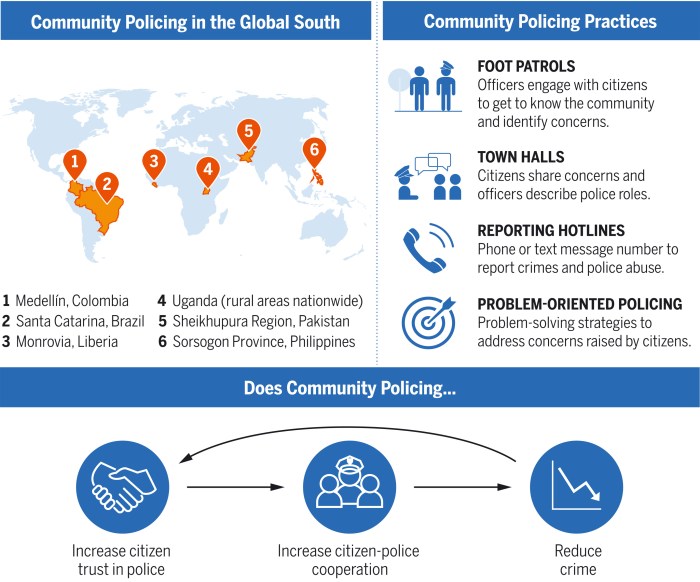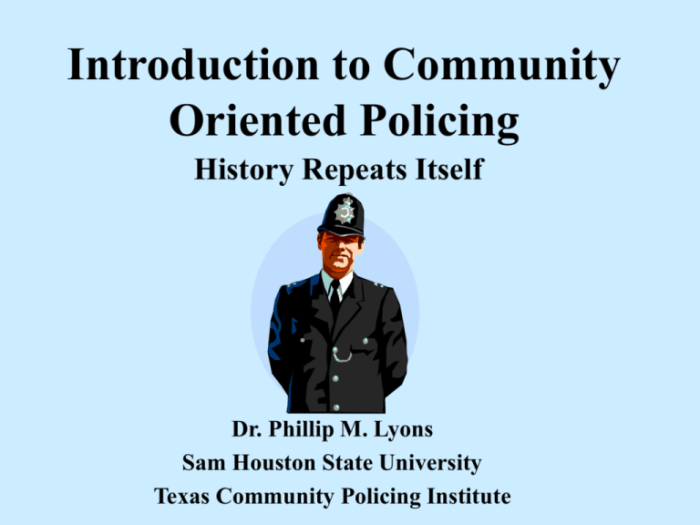Community oriented policing strategies have proven successful in transforming law enforcement and fostering safer communities. This innovative approach prioritizes collaboration between police officers and residents, leading to a reduction in crime rates, improved community relations, and enhanced public trust.
COP strategies involve engaging with community members to identify and address local concerns, building partnerships with community organizations, and implementing problem-solving initiatives that focus on long-term solutions rather than solely on reactive responses to crime.
Definition of Community Oriented Policing (COP)

Community policing is a policing strategy that focuses on building partnerships between the police and the community. It is based on the belief that the police can be more effective in preventing and reducing crime if they work closely with the community to identify and address its problems.
The principles of community policing include:
- Collaboration: Police and community members work together to identify and solve problems.
- Proactivity: Police officers are proactive in preventing crime and addressing community concerns.
- Problem-solving: Police officers use problem-solving techniques to identify the root causes of crime and develop effective solutions.
- Community engagement: Police officers are engaged with the community and build relationships with residents.
COP has evolved over time, from its roots in the 1960s to its current form. Today, COP is widely recognized as an effective crime prevention strategy.
Implementation of COP Strategies: Community Oriented Policing Strategies Have Proven Successful In
COP programs have been implemented in communities across the United States and around the world. Some successful COP programs include:
- The Problem-Oriented Policing (POP) program in Newport News, Virginia, which reduced crime by 25%.
- The Community Policing Initiative (CPI) in Chicago, Illinois, which reduced crime by 17%.
- The Neighbourhood Policing Program (NPP) in London, England, which reduced crime by 10%.
Key components of successful COP programs include:
- Community engagement: Police officers build relationships with residents and involve them in the planning and implementation of COP programs.
- Partnerships: Police officers partner with other agencies, such as schools, social service agencies, and businesses, to address community problems.
- Problem-solving: Police officers use problem-solving techniques to identify the root causes of crime and develop effective solutions.
COP programs face a number of challenges, including:
- Funding: COP programs can be expensive to implement.
- Staffing: COP programs require additional police officers to be effective.
- Community resistance: Some community members may be resistant to COP programs, fearing that they will lead to increased police presence or surveillance.
Impact of COP on Crime Rates

Empirical evidence suggests that COP can have a significant impact on crime rates. A study by the National Institute of Justice found that COP programs reduced crime by an average of 10%.
COP has been shown to be effective in reducing a variety of crimes, including:
- Violent crime
- Property crime
- Drug crime
- Disorderly conduct
COP reduces crime by:
- Increasing police presence in the community
- Building relationships between police officers and residents
- Empowering residents to take ownership of their community
COP and Community Relations

COP has a positive impact on community relations. A study by the Police Executive Research Forum found that COP programs increased community trust in the police by 20%.
COP fosters positive relationships between police officers and residents by:
- Building relationships through face-to-face interactions
- Involving residents in the planning and implementation of COP programs
- Addressing community concerns and needs
Successful community-police partnerships are based on:
- Trust: Residents trust that the police are there to protect and serve them.
- Legitimacy: Residents believe that the police are acting fairly and justly.
- Accountability: Residents have a say in how the police are run.
Challenges and Future Directions

COP programs face a number of challenges, including:
- Funding: COP programs can be expensive to implement.
- Staffing: COP programs require additional police officers to be effective.
- Community resistance: Some community members may be resistant to COP programs, fearing that they will lead to increased police presence or surveillance.
- Lack of evaluation: Many COP programs are not evaluated, making it difficult to determine their effectiveness.
Despite these challenges, COP remains a promising crime prevention strategy. Future directions for COP include:
- Developing more effective evaluation methods
- Expanding the use of technology to support COP programs
- Developing new strategies to address emerging crime problems
FAQ Overview
What are the key components of community oriented policing?
COP involves building partnerships with community members, identifying and addressing local concerns, and implementing problem-solving initiatives that focus on long-term solutions.
How does COP impact crime rates?
COP has been shown to reduce crime rates by improving community relations, increasing trust in law enforcement, and promoting problem-solving approaches that address the root causes of crime.
What are the challenges of implementing COP strategies?
Challenges include gaining community trust, overcoming resistance from traditional policing methods, and ensuring sustainable funding and resources for COP programs.